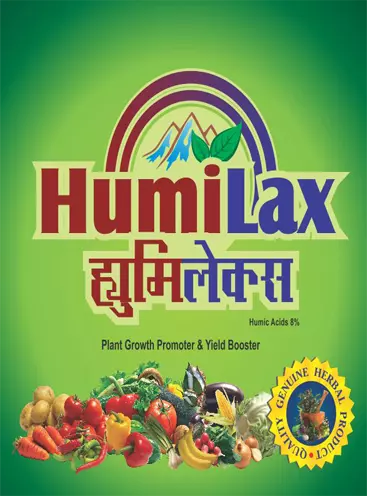
Viro Wash treats almost all viral, bactarial & fungal diseases Genius repel sucking pest, solve leaf minor problems & stops flower shedding.

Humilax improves crop yield by:
Accelerating germination, Enhancing seedling vigour and root growth. Improving uptake and translocation of micro and macro nutrients. Helping plants to resist drought, resulting in higher yields and better quality of crops produce.

Water soluble, easy to apply economical and faster actiong.
Suppresses soil and root pathogens.
Increases crop yield, promoting fruit enlargement and quality.
Aids in root formation.
Stimulates plant enzymes and hormones.
Improves soil fertility and soil microbial activity.
Sanjeevani is an Biotechnology Protein mixture of Enzyme & Amino Acids. Sanjeevani is mixture of organic protein & create an effective compound with this.
Sanjeevani contains metallic proteins and Enzymes with selected base mixture Sanjeevani which results in extraordinary growth gives Flowering & Fruiting in cotton, soyabean, paddy, groundnut, wheat, Chillies, garlic, potato, onion & other vegetables and all types of fruits.
Sanjeevani induce rapid growth.
Sanjeevani is non toxic & easily soluble in water & speedily mixed with liquid pesticides.
Control of Caterpillar and other bacteria is big issue for formers. Different type of Caterpillar attack on Cotton, Soyabeen and all type of Vegetables, so to overcome from this problem Hunter is best controller of Caterpillar and other bacteria. Hunter resist the growth and attack of caterpillar which results in better plant growth and increases the production.
Organic fertilizer for brinjal, organic fertilizer for pepper, organic fertilizer for cotton, organic fertilizer for papaya, organic fertilizer for papaya, organic fertilizer for tomato.
Today, biofertilisers are more widely used because they are non-polluting and biodegradable. One of the main examples used in agriculture and horticulture is organic fertilisers. Biotechnology and bio-industries are transforming many of the physico-chemical industries that cause atmospheric pollution. Biofertilisers are used for a wide range of purposes, which are listed below:
Cereals, vegetables and various uses such as food and horticulture.
agricultural uses
bioremediation
forestry
fish farming and aquaculture
transport and waste management
The use of biofertilisers is increasing day by day as the world experiences the effects of global warming caused by various chemical fertilisers.
Organic fertilizer for chilli
Chilli is one of the major producers of vegetable spices and the use of organic fertilizers on chilli improves its growth and at low cost compared to chemical fertilizers. Therefore, the use of organic fertilizers increases the yield of chillies.
There are many types of fertilizers and they usually meet many of the requirements of the garden. How to help crops with nutrients and help them thrive quickly removes unwanted plants and helps plants survive. You also have the option of buying organic or biofertiliser for a healthier lawn, or choosing another fertiliser option.
Organic fertilizer for brinjal
Brinjal or eggplant (Solanum melongena L.) is an important seed crop grown in India. In India, it is one of the most common, popular and important vegetable crops grown throughout the country, except in the higher altitudes. It is an adaptable crop, adapted to different agro-climatic zones. To protect against diseases and worms, it is important to use organic fertilisers when growing brinjal. Brinjal can be grown all year round. It is a perennial crop, but commercially it is grown as an annual. Brinjal varieties have a wide range of crop shapes and colours, ranging from oval or egg-shaped to elongated wreath-shaped and from yellow, white, green, purple pigmented to almost black.
Biofertilizer for cotton
Crop rotation with cover crops, green manuring, compost, organic mulch and biofertilizers for cotton are widely used to improve productivity. Soil conditioners made with approved chemicals can be used to improve crop productivity. Himalayan Agro Science offers better quality and many products are ISO 9001 certified. We offer our customers value for money through savings in product range, continuous product development and higher product value.
Ladyfinger biofertilizer
Ladyfinger is a very popular vegetable grown in India. It is often called Bhind and grows well during the summer months. The flowers of the plant are very attractive and beautify the garden when in full bloom. One of the main reasons why many farmers prefer okra is that the plant requires very little maintenance and once one legume is harvested, another legume grows in its place.
When the young okra plant approaches its maximum growth, it is prone to major pest attacks. Therefore, in order to rule out all diseases of the plants, the use of biofertilizer for ladybirds will be necessary.
Biofertilizer for tomatoes
Tomatoes need an early start, a long season, special nutrients, creep support and unparalleled care. When it comes to fertilizer, tomatoes are indomitable. In horticulture, they are heavy feeders, meaning they need large amounts of nutrients and fertilizer a week before and on the day of planting. They are especially fond of phosphorus, which supports the formation of flowers and the fruits or vegetables that develop from them. Ignore increasing nitrogen levels when your tomato plants are flowering, as this not only promotes fruit development but also creeping growth. Therefore, using a tomato biofertilizer helps the growth of flowers and fruits.
Biofertilizer for papaya
The papaya tree (Carica papaya) is a stately, single-column tree that will beautify your garden, not to mention its juicy, robust fruits that are naturally rich in vitamin C. Since papaya trees are relatively low maintenance, they need to be well fertilized to ensure rapid growth and the best possible fruit set.
Papaya can be grown in flat areas from sea level up to 1000 m altitude. However, the best soil elevation is between 50 and 700 m above sea level. These plants need about 1000-2000 mm of rainwater per year, evenly distributed throughout the year. A papaya tree that is seasonally dry in the region can still be productive with daily watering.
Papaya is a herbaceous plant that can grow up to three meters high. The stem is hollow, tuberous in texture and thin. This plant has a taproot and its roots are on the muddy side. Papaya There are three kinds of papaya flowers, on the basis of the nature of the flower. The papaya tree can be male tree, female and the tree ideally. Male papaya trees do not develop fruit, whereas the female papaya tree can develop fruit that is surrounded, and includes thin flesh. Papaya fruit needed with a lengthened shape developed from papaya tree is ideal.
And, using daily Bio Fertilizer for Papaya with an impartial, all-purpose fertilizer will assist in supporting suitable papaya tree enlargement and fruit growth.
